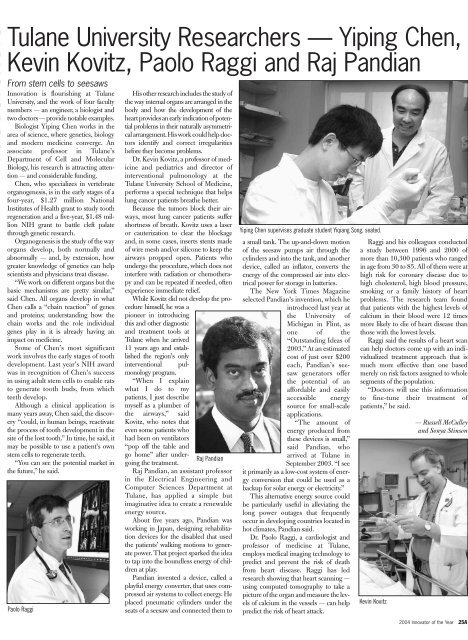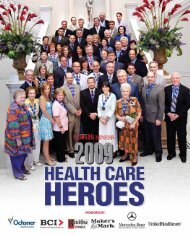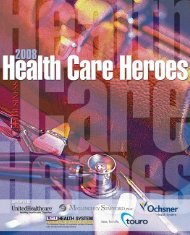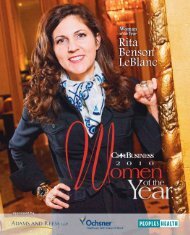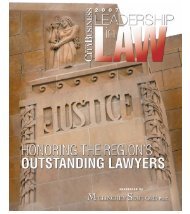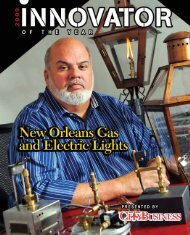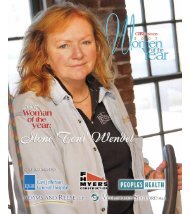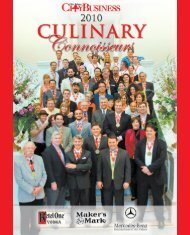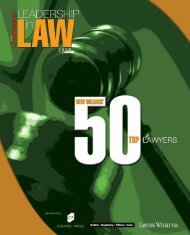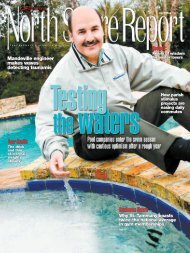Ingenuity - New Orleans City Business
Ingenuity - New Orleans City Business
Ingenuity - New Orleans City Business
- No tags were found...
Create successful ePaper yourself
Turn your PDF publications into a flip-book with our unique Google optimized e-Paper software.
esearchersTulane University Researchers — Yiping Chen,Kevin Kovitz, Paolo Raggi and Raj PandianFrom stem cells to seesawsInnovation is flourishing at TulaneUniversity, and the work of four facultymembers — an engineer, a biologist andtwo doctors — provide notable examples.Biologist Yiping Chen works in thearea of science, where genetics, biologyand modern medicine converge. Anassociate professor in Tulane’sDepartment of Cell and MolecularBiology, his research is attracting attention— and considerable funding.Chen, who specializes in vertebrateorganogenesis, is in the early stages of afour-year, $1.27 million NationalInstitutes of Health grant to study toothregeneration and a five-year, $1.48 millionNIH grant to battle cleft palatethrough genetic research.Organogenesis is the study of the wayorgans develop, both normally andabnormally — and, by extension, howgreater knowledge of genetics can helpscientists and physicians treat disease.“We work on different organs but thebasic mechanisms are pretty similar,”said Chen. All organs develop in whatChen calls a “chain reaction” of genesand proteins; understanding how thechain works and the role individualgenes play in it is already having animpact on medicine.Some of Chen’s most significantwork involves the early stages of toothdevelopment. Last year’s NIH awardwas in recognition of Chen’s successin using adult stem cells to enable ratsto generate tooth buds, from whichteeth develop.Although a clinical application ismany years away, Chen said, the discovery“could, in human beings, reactivatethe process of tooth development in thesite of the lost tooth.” In time, he said, itmay be possible to use a patient’s ownstem cells to regenerate teeth.“You can see the potential market inthe future,” he said.Paolo RaggiHis other research includes the study ofthe way internal organs are arranged in thebody and how the development of theheart provides an early indication of potentialproblems in their naturally asymmetricalarrangement.His work could help doctorsidentify and correct irregularitiesbefore they become problems.Dr. Kevin Kovitz, a professor of medicineand pediatrics and director ofinterventional pulmonology at theTulane University School of Medicine,performs a special technique that helpslung cancer patients breathe better.Because the tumors block their airways,most lung cancer patients suffershortness of breath. Kovitz uses a laseror cauterization to clear the blockageand, in some cases, inserts stents madeof wire mesh and/or silicone to keep theairways propped open. Patients whoundergo the procedure, which does notinterfere with radiation or chemotherapyand can be repeated if needed, oftenexperience immediate relief.While Kovitz did not develop the procedurehimself, he was apioneer in introducingthis and other diagnosticand treatment tools atTulane when he arrived11 years ago and establishedthe region’s onlyinterventional pulmonologyprogram.“When I explainwhat I do to mypatients, I just describemyself as a plumber ofthe airways,” saidKovitz, who notes thateven some patients whohad been on ventilators“pop off the table andgo home” after undergoingthe treatment.Raj PandianRaj Pandian, an assistant professorin the Electrical Engineering andComputer Sciences Department atTulane, has applied a simple butimaginative idea to create a renewableenergy source.About five years ago, Pandian wasworking in Japan, designing rehabilitationdevices for the disabled that usedthe patients’ walking motions to generatepower. That project sparked the ideato tap into the boundless energy of childrenat play.Pandian invented a device, called aplayful energy converter, that uses compressedair systems to collect energy. Heplaced pneumatic cylinders under theseats of a seesaw and connected them toYiping Chen supervises graduate student Yiqiang Song, seated.a small tank. The up-and-down motionof the seesaw pumps air through thecylinders and into the tank, and anotherdevice, called an inflator, converts theenergy of the compressed air into electricalpower for storage in batteries.The <strong>New</strong> York Times Magazineselected Pandian’s invention, which heintroduced last year atthe University ofMichigan in Flint, asone of the“Outstanding Ideas of2003.” At an estimatedcost of just over $200each, Pandian’s seesawgenerators offerthe potential of anaffordable and easilyaccessible energysource for small-scaleapplications.“The amount ofenergy produced fromthese devices is small,”said Pandian, whoarrived at Tulane inSeptember 2003. “I seeit primarily as a low-cost system of energyconversion that could be used as abackup for solar energy or electricity.”This alternative energy source couldbe particularly useful in alleviating thelong power outages that frequentlyoccur in developing countries located inhot climates, Pandian said.Dr. Paolo Raggi, a cardiologist andprofessor of medicine at Tulane,employs medical imaging technology topredict and prevent the risk of deathfrom heart disease. Raggi has ledresearch showing that heart scanning —using computed tomography to take apicture of the organ and measure the levelsof calcium in the vessels — can helppredict the risk of heart attack.Raggi and his colleagues conducteda study between 1996 and 2000 ofmore than 10,300 patients who rangedin age from 30 to 85. All of them were athigh risk for coronary disease due tohigh cholesterol, high blood pressure,smoking or a family history of heartproblems. The research team foundthat patients with the highest levels ofcalcium in their blood were 12 timesmore likely to die of heart disease thanthose with the lowest levels.Raggi said the results of a heart scancan help doctors come up with an individualizedtreatment approach that ismuch more effective than one basedmerely on risk factors assigned to wholesegments of the population.“Doctors will use this informationto fine-tune their treatment ofpatients,” he said.Kevin Kovitz— Russell McCulleyand Sonya Stinson2004 Innovator of the Year 25A


